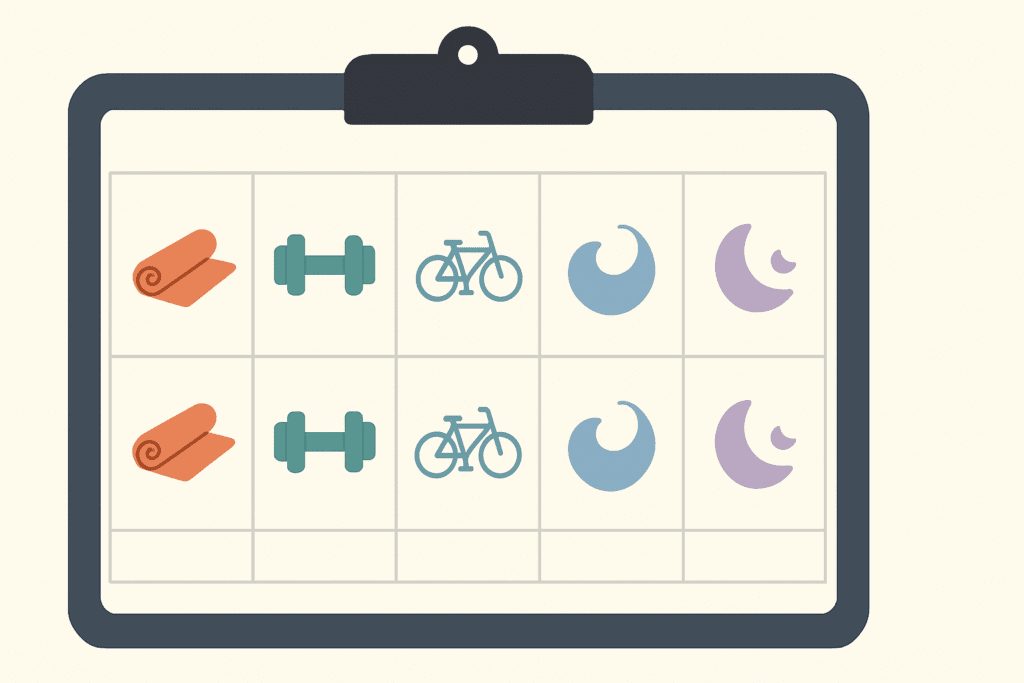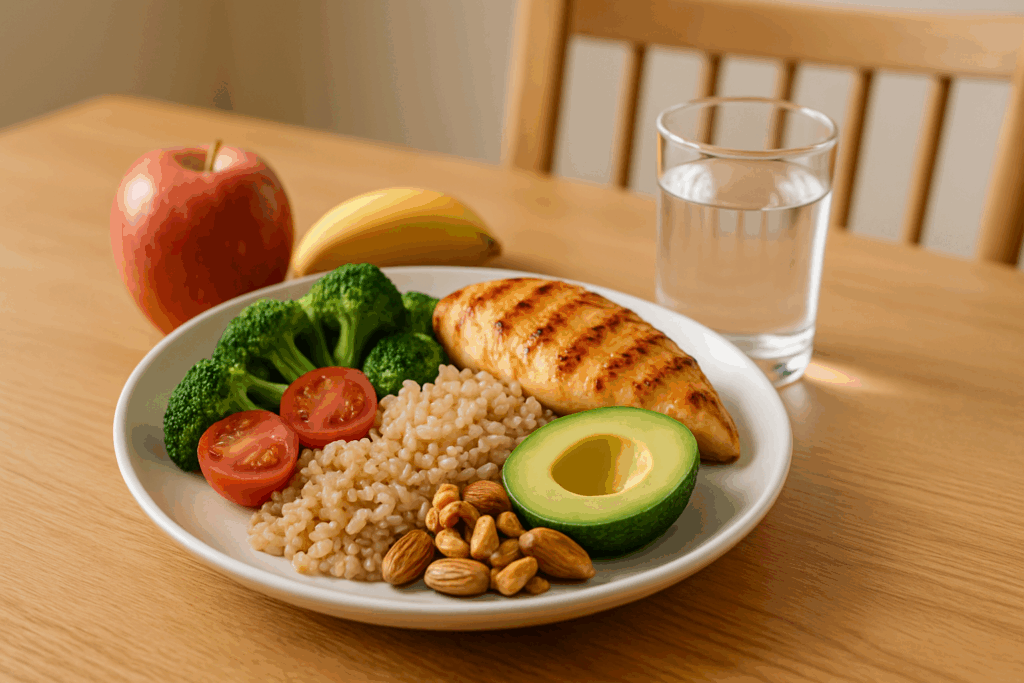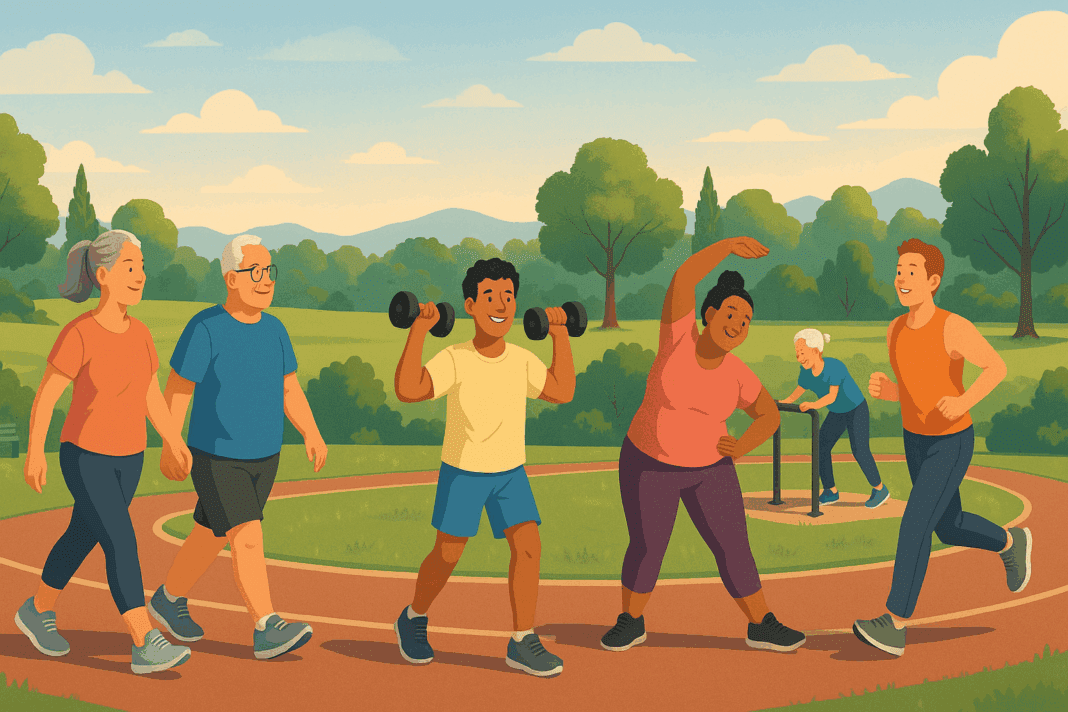Introduction: Why a Structured Workout Plan Matters for Beginners
Beginning a fitness journey can feel overwhelming, especially when you’re bombarded with conflicting advice and endless routines. For beginners, knowing where to start is often the hardest part. But establishing a structured workout timetable is one of the most effective ways to build consistency, boost motivation, and ensure you’re working toward real, measurable progress. Without a clear direction, workouts can become sporadic, ineffective, and discouraging. That’s where a smart and personalized fitness schedule comes into play. It not only helps you navigate the complex world of fitness but also ensures that your time and energy are invested wisely.
For those focused on building endurance and enhancing performance, a consistent workout plan tailored to their fitness level is essential. This article presents an expertly designed workout timetable for beginners, crafted to gradually improve stamina while minimizing the risk of injury or burnout. Whether your goal is to run a 5K, increase muscular stamina, or simply feel more energetic throughout the day, this guide provides evidence-based strategies rooted in physiological science and practical application. A structured approach also aligns with the EEAT (Experience, Expertise, Authoritativeness, and Trustworthiness) principles that ensure health and wellness advice is both accurate and beneficial.
You may also like: Build Running Stamina Fast: Best Exercises to Increase Endurance and Boost Performance Naturally

Understanding the Foundations of Endurance and Performance
Before diving into your fitness schedule, it’s important to understand what endurance and performance really mean in a physiological context. Endurance refers to the body’s ability to sustain physical activity over an extended period. It involves cardiovascular efficiency, muscular stamina, and mental resilience. Performance, on the other hand, encompasses how effectively your body can execute tasks, from lifting weights to running sprints, and includes factors such as strength, speed, agility, and coordination.
Building endurance requires consistent aerobic conditioning, while boosting performance calls for a mix of cardio, strength training, flexibility, and rest. These two goals are intertwined, and your workout timetable should reflect a balance that supports both. Beginners should not aim for intensity right out of the gate. Instead, a gradual progression ensures that muscles, joints, and connective tissues adapt appropriately. This avoids injuries and encourages long-term adherence to the fitness plan.
Adopting a scientifically backed approach helps align workouts with biological adaptations. For instance, aerobic workouts increase mitochondrial density in muscle cells, improving oxygen utilization and energy output. Strength training enhances neuromuscular coordination, muscle fiber recruitment, and hormonal balance. Together, these adaptations amplify your overall performance and build a solid foundation for long-term fitness.

Creating a Personalized Workout Timetable for Beginners
When developing a workout timetable for beginners, the focus should be on variety, progression, and recovery. The week should be strategically divided to include cardiovascular training, strength development, active recovery, and flexibility work. An example of a well-rounded beginner fitness schedule might look like this:
- Monday: Full-body strength training
- Tuesday: Low-impact cardio (e.g., brisk walking or cycling)
- Wednesday: Rest or active recovery (yoga, stretching)
- Thursday: Upper-body strength training
- Friday: Light cardio with intervals
- Saturday: Lower-body strength and endurance
- Sunday: Rest or mindfulness-based activity (e.g., meditation, nature walk)
This basic framework can be adjusted based on your schedule, energy levels, and fitness goals. The key is consistency. Even a light workout list can yield impressive results if performed regularly and with intention. For those just beginning, each session should last between 30 to 45 minutes, focusing on quality over quantity. Warm-ups and cooldowns are essential components of any workout, preparing the body for exertion and facilitating recovery afterward.
The Role of Cardiovascular Exercise in Building Stamina
Cardio is a cornerstone of any endurance-building routine. For beginners, this doesn’t mean jumping straight into high-intensity interval training (HIIT) or hour-long runs. Instead, the goal is to develop aerobic capacity gradually. Walking, swimming, cycling, or low-impact dance classes are excellent starting points. These activities increase heart rate, improve circulation, and boost lung function without overwhelming the body.
Consistency is critical in cardio training. Three to four sessions per week of moderate-intensity activity can significantly enhance endurance within a few weeks. A well-planned fitness schedule for beginners should prioritize variety to maintain engagement and prevent overuse injuries. One day might include a 30-minute walk around the neighborhood, while another could involve a light jog or elliptical session. As your fitness level increases, you can begin incorporating interval training or longer sessions to challenge your aerobic threshold.
Moreover, cardiovascular training has mental health benefits, including reduced anxiety and improved mood, which further support motivation. Beginners who associate movement with positive emotional outcomes are more likely to stick with their program. This alignment of physical and mental benefits makes cardio a non-negotiable part of any effective workout timetable for beginners.

Integrating Strength Training for Performance Enhancement
While cardio supports endurance, strength training is vital for performance enhancement. Building muscle mass, increasing bone density, and improving metabolic rate are all advantages of resistance-based workouts. For beginners, bodyweight exercises such as squats, push-ups, lunges, and planks form the foundation of a light workout list that is both accessible and effective.
Incorporating strength training into a beginner’s fitness schedule helps develop functional fitness—the ability to perform everyday tasks with ease and efficiency. Two to three non-consecutive days of strength work per week allow for adequate muscle recovery while promoting growth. Beginners should focus on mastering form before adding external weights. Using resistance bands, light dumbbells, or even household objects like water bottles can enhance workouts without requiring a gym membership.
Additionally, strength training supports cardiovascular performance by improving muscular efficiency and reducing fatigue. A stronger body can perform aerobic tasks with less strain, creating a synergy between the different components of your workout timetable. It’s also a powerful tool for long-term weight management and injury prevention. Properly balanced strength sessions target all major muscle groups and include push, pull, hinge, squat, and core movements.

Recovery and Rest: The Overlooked Essentials in Any Fitness Schedule
Many beginners underestimate the value of rest and recovery, mistakenly believing that more exercise equals faster results. In reality, the body needs downtime to repair tissues, regulate hormones, and replenish energy stores. Without proper recovery, workouts can lead to fatigue, decreased performance, and even injury. A well-designed workout timetable for beginners builds in adequate rest days and lighter activity options to support regeneration.
Active recovery days—which may include gentle yoga, foam rolling, or walking—help maintain blood flow and flexibility without causing additional stress to the body. These sessions should be as intentional as more intense workouts. Sleep also plays a crucial role in recovery. During deep sleep cycles, the body releases growth hormone, which is essential for muscle repair and performance enhancement.
Including recovery in your fitness schedule ensures a sustainable approach. It teaches beginners to listen to their bodies, recognize signs of overtraining, and prioritize self-care as part of the fitness journey. Flexibility in scheduling is important, too. Life happens, and your body’s energy levels will vary. Allowing room to adapt your schedule without guilt supports long-term success.

The Importance of a Light Workout List for Active Recovery and Beginners
Not all workouts need to push you to your limits. In fact, a light workout list can be one of the most important tools in a beginner’s arsenal. These lower-intensity sessions keep you moving without the stress that comes from heavier or more complex routines. Think of stretching sessions, Pilates, slow-paced yoga, or even leisurely bike rides. These activities offer both physical and mental benefits while promoting circulation and mobility.
For beginners who are just developing body awareness and coordination, these light workouts provide a safe space to explore movement. They are particularly valuable on days when energy is low or recovery is needed. Incorporating a light workout list into your regular rotation encourages consistency, helps prevent injury, and enhances overall enjoyment of your fitness journey.
Moreover, these lighter days serve as checkpoints. They offer a chance to reflect on progress, tune in to your body’s signals, and mentally reset. When integrated into a structured timetable, light workouts provide balance, reduce the risk of burnout, and maintain the momentum necessary to stick with your fitness schedule long-term.
Fueling Your Fitness: Nutrition and Hydration Strategies for Optimal Results
While your workout timetable sets the foundation, nutrition and hydration determine how effectively your body responds to training. Eating the right foods at the right times provides the energy needed for performance and the nutrients required for recovery. For beginners, the emphasis should be on whole, unprocessed foods—lean proteins, complex carbohydrates, healthy fats, and plenty of fruits and vegetables.
Carbohydrates are your body’s preferred energy source for moderate to intense workouts. Incorporating them into pre- and post-workout meals helps maintain energy and promote recovery. Protein supports muscle repair and growth and should be consumed consistently throughout the day. Healthy fats contribute to hormone production and joint lubrication, supporting long-term performance and recovery.
Hydration is equally important. Dehydration impairs both physical and cognitive performance. Water supports temperature regulation, nutrient transport, and joint health. Beginners should aim to drink water consistently throughout the day, not just during workouts. Adding a pinch of salt or an electrolyte tablet after intense sessions can aid in replenishment and recovery.
Understanding your body’s needs and fueling accordingly enhances the impact of your fitness schedule. It helps ensure that each workout, whether intense or light, contributes meaningfully to your endurance and performance goals.
Tracking Progress and Staying Motivated Over Time
Sustaining motivation is one of the greatest challenges for beginners. Fortunately, tracking your progress offers both accountability and inspiration. This doesn’t mean obsessively checking the scale—in fact, non-scale victories like improved energy, better sleep, increased strength, and enhanced mood are often more meaningful indicators of success.
Maintaining a journal or using a fitness app to log workouts can help identify patterns, track milestones, and celebrate achievements. Over time, you may notice how your cardio sessions have lengthened, your strength has improved, or your need for rest days has decreased. These are all signs of increased endurance and better overall fitness.
Setting SMART goals—Specific, Measurable, Achievable, Relevant, and Time-bound—can provide structure and purpose. For example, aiming to complete a full-body strength workout three times a week for a month is a tangible goal that supports consistency and motivation. Pairing these goals with rewards, such as new workout gear or a relaxing spa day, can reinforce positive behavior.
Staying connected with a supportive community, whether online or in-person, also enhances accountability. Sharing your journey, asking questions, and celebrating wins together makes the experience more engaging and less isolating. Ultimately, a thoughtfully designed workout timetable for beginners is not just a schedule—it’s a roadmap to a stronger, healthier, and more empowered version of yourself.
Frequently Asked Questions: Smart Workout Timetable for Beginners
1. How can I stay consistent with a workout timetable for beginners despite a busy lifestyle? Staying consistent often requires shifting your mindset from “finding time” to “making time.” One underrated strategy is treating your workouts like non-negotiable appointments. If you build your fitness schedule for beginners into your calendar alongside meetings or classes, you’re more likely to stick with it. Consider the cumulative value of shorter sessions, too—three 15-minute workouts throughout the day can be just as beneficial as one longer session. You can also alternate high- and low-effort days by mixing in a light workout list to maintain momentum even on stressful or hectic days.
2. What’s the best way to measure progress when following a beginner fitness schedule? Progress isn’t always reflected on a scale. It’s helpful to keep a fitness journal where you log energy levels, workout duration, intensity, and how you felt before and after each session. Using this data over time reveals meaningful patterns. For example, noticing fewer breaks during your cardio sessions or increased ease during bodyweight movements indicates improvement. Incorporating a structured workout timetable for beginners also allows you to track adherence and consistency—essential factors for long-term success.
3. Are there psychological benefits to sticking with a fitness schedule for beginners? Absolutely. Beyond the endorphin release from physical activity, a consistent fitness schedule helps regulate mood and reduce anxiety. It also creates a sense of structure and control, which is especially helpful during stressful or transitional phases in life. Many beginners find that committing to even a light workout list helps improve sleep quality and cognitive focus. Building a routine fosters self-efficacy, reinforcing the belief that you’re capable of achieving meaningful change.
4. What if I miss a workout—how should I adjust my timetable? Missing a workout isn’t the end of your progress; it’s an opportunity to reflect and recalibrate. Rather than cramming missed workouts into subsequent days, allow the timetable to flex while maintaining balance. You can shift activities forward by a day or replace a more demanding session with a light workout list. The goal is to uphold the rhythm of your fitness schedule for beginners without risking fatigue or burnout. Consistency over time matters more than perfection each week.
5. Can I follow a workout timetable for beginners at home without special equipment? Definitely. A home-based fitness schedule for beginners can be highly effective with the right strategy. Use bodyweight exercises like squats, planks, and push-ups, and incorporate dynamic movements such as mountain climbers and jumping jacks to build endurance. Resistance bands, household objects, or even stairs can substitute for gym machines. Pairing these routines with a light workout list for recovery days ensures a well-rounded, gym-free plan that still yields real results.
6. How do I maintain motivation during the early stages of a beginner workout plan? Motivation often follows action—not the other way around. One practical approach is habit stacking, where you pair your workout with an existing routine, like exercising right after your morning coffee. Creating mini-milestones within your workout timetable for beginners gives you regular wins to celebrate. Visual cues, such as placing your sneakers near your bed or setting up a dedicated workout space, can also serve as consistent reminders. Alternating your weekly routine with a light workout list helps prevent boredom and keeps engagement high.
7. What role does social support play in sticking to a fitness schedule for beginners? Social accountability can significantly increase commitment and enjoyment. Whether you join an online challenge, check in with a friend, or share your workout timetable with a mentor, involving others fosters consistency. It also provides emotional reinforcement—celebrating milestones and overcoming plateaus becomes a shared experience. Even participating in group activities from a light workout list, like walking clubs or beginner yoga classes, builds community. This connection can transform exercise from a chore into a source of motivation.
8. How can I adapt my workout timetable for beginners if I travel frequently? Travel doesn’t have to derail your routine if you’re flexible and resourceful. Create a portable light workout list that includes bodyweight circuits, yoga flows, or stair climbing that can be done in a hotel room or outdoor space. Mobile fitness apps and travel-sized resistance bands offer extra versatility. Keeping your fitness schedule for beginners adaptable means focusing on frequency and movement rather than perfection. Even 15 to 20 minutes of activity helps maintain consistency and reduces the physical toll of long travel days.
9. Are there signs that my beginner fitness schedule needs to be modified? Yes—persistent fatigue, frequent soreness, lack of motivation, or plateauing performance may signal it’s time for adjustments. These red flags indicate either overtraining or under-stimulation. If you feel overly drained, integrating more recovery or a light workout list can aid in balancing exertion and rest. On the other hand, if you find the workouts too easy, gradually increasing intensity or duration helps sustain progress. Listening to your body ensures that your workout timetable for beginners evolves with your needs.
10. How long should I stick with a beginner plan before progressing to intermediate training? While there’s no universal timeline, a solid benchmark is around 8 to 12 weeks of consistent activity. By this point, your body typically adapts to the demands of a fitness schedule for beginners, making it easier to handle more challenging routines. You should see improvements in stamina, strength, and recovery time. At this stage, you can gradually phase in higher resistance, more complex movements, or additional workout days. Retaining a light workout list even during this transition supports active recovery and helps avoid overtraining as you progress.
Conclusion: Building a Sustainable Fitness Journey with Confidence and Clarity
Embarking on a fitness journey doesn’t require perfection—it requires a plan. By developing a smart workout timetable for beginners, you can maximize your energy, enhance endurance, and steadily improve performance without overwhelming yourself. A well-balanced approach that integrates strength training, cardiovascular exercise, rest, and light activity creates a comprehensive and sustainable pathway to long-term wellness.
The journey to improved stamina and peak physical output doesn’t happen overnight, but with dedication and a structured fitness schedule for beginners, tangible results are within reach. Remember, even a light workout list contributes to your success, offering recovery, mobility, and mental clarity. Listening to your body, tracking progress, and fueling yourself with proper nutrition will further support your goals and encourage consistency.
Above all, fitness is about feeling good in your body, building confidence, and expanding your capabilities. With each workout, you’re not just burning calories—you’re cultivating resilience, strength, and self-respect. Stick with the plan, adapt when needed, and trust in your process. Your energy, performance, and well-being will thank you.
Was this article helpful? Don’t let it stop with you. Share it right now with someone who needs to see it—whether it’s a friend, a colleague, or your whole network. And if staying ahead on this topic matters to you, subscribe to this publication for the most up-to-date information. You’ll get the latest insights delivered straight to you—no searching, no missing out.
Further Reading:
How to Start Exercising: A Beginner’s Guide to Working Out
What a Complete Workout Schedule Looks Like
Disclaimer
The information contained in this article is provided for general informational purposes only and is not intended to serve as medical, legal, or professional advice. While NewsHealthWatch strives to present accurate, up-to-date, and reliable content, no warranty or guarantee, expressed or implied, is made regarding the completeness, accuracy, or adequacy of the information provided. Readers are strongly advised to seek the guidance of a qualified healthcare provider or other relevant professionals before acting on any information contained in this article. NewsHealthWatch, its authors, editors, and contributors expressly disclaim any liability for any damages, losses, or consequences arising directly or indirectly from the use, interpretation, or reliance on any information presented herein. The views and opinions expressed in this article are those of the author(s) and do not necessarily reflect the official policies or positions of NewsHealthWatch.

